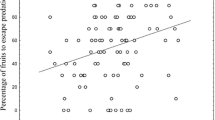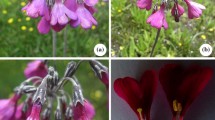Abstract
Negative frequency dependent selection (FDS) had been proposed as a mechanism for the maintenance of the high levels of variability in floral traits of rewardless plants. Thus far the evidence has been equivocal for discontinuous traits. We experimentally tested the FDS hypothesis for continuous variation in flower color of Psychilis monensis, a rewardless, epiphytic orchid of Mona Island, Puerto Rico. P. monensis flowers all year long with a peak in June and July. Plants are self-incompatible. Individual flowers last 9–15 days if unpollinated. Over a 9-month observation of an unmanipulated population, a high percentage of plants showed pollinarium removals (79%) and fruit initiation (63%), but the actual percentage of flowers visited was very low (12%) and final fruit set was as low as the lowest recorded for orchids (2.4%). In a FDS experiment using a Latin Square design, we manipulated flower color in three populations. Over 50% of the variation in either male or female reproductive success was explained by time and site with no significant effect of treatment except as part of a three-way interaction of time × site × treatment. Paired comparisons with the controls gave equivocal results for both male and female measures of reproductive success. Major community changes had occurred during the FDS experiment with flower activity falling dramatically and by the third run of the experiment, only P. monensis was in flower. Coincidentally, the numbers of effective visits increased with time, presumably as pollinators became less discriminating in search of new food resources. Thus, negative frequency dependent selection is either sporadic or non-existent. Reproductive success was statistically related to locality and date, which was reflected in the flowering phenology of the local communities. High natural levels of color variation may be more influenced by drift than selection.



Similar content being viewed by others
References
Ackerman JD (1981) Pollination of Calypso bulbosa var. occidentalis (Orchidaceae): a food deception system. Madroño 28:101–110
Ackerman JD (1986) Mechanisms and evolution of food-deceptive pollination systems in orchids. Lindleyana 1:108–113
Ackerman JD (1989) Limitations to sexual reproduction and the evolution of deception pollination in Encyclia krugii (Orchidaceae). Syst Bot 14:101–109
Ackerman JD, Galarza-Pérez M (1991) Patterns and maintenance of extraordinary variation in the Caribbean orchid, Tolumnia (Oncidium) variegata. Syst Bot 16:182–194
Ackerman JD, Rodríguez-Robles JA, Meléndez EJ (1994) A meager nectar offering by an epiphytic orchid is better than nothing. Biotropica 26:44–49
Ackerman JD, Meléndez-Ackerman EJ, Salguero-Faria J (1997) Variation in pollinator abundance and selection on fragrance phenotypes in an epiphytic orchid. Am J Bot 84:1383–1390
Aragón S (2002) Variation and frequency dependent selection on flower color in Psychilis monensis (Orchidaceae). Master’s Thesis. University of Puerto Rico, Rio Piedras Campus, Puerto Rico
Brower JE, Zar JH, von Ende CN (1997) Field and laboratory methods for general ecology. 4th edn. WCB/McGraw-Hill, Boston, Massachusetts, pp 180–182
Chittka L, Menzel R (1992) The evolutionary adaptation of flower colours and the insect pollinators’ colour vision. J Comp Physiol 171:171–181
Chittka L, Spaethe J, Schmidt A, Hickelsberger A (2001) Adaptation, constraint, and chance in the evolution of flower color and pollinator color vision. In: Chittka L Thomson JD (eds) Cognitive ecology of pollination. Cambridge University Press, Cambridge, pp 106–126
Cole FR, Firmage DH (1984) The floral ecology of Platanthera blephariglottis. Am J Bot 71:700–710
Collias NE, Collias EC (1968) Anna’s hummingbird trained to select different colors in feeding. Condor 70:273–275
Cropper SC, Calder DM (1990) The floral biology of Thelymitra epipactoides (Orchidaceae), and the implications of pollination by deceit on the survival of this rare orchid. Plant Syst Evol 170:11–27
Dafni A (1987) Pollination in Orchis and related genera: evolution from reward to deception. In: Arditti J (ed) Orchid biology: Rev Perspect 4:79–104
Dukas R, Real LA (1993) Learning constrains and floral choice behavior in bumble bees. Anim Behav 19:566–574
Endler JA (1990) On the measurement and classification of colour in studies of animal colour patterns. Biol J Linn Soc 41:315–352
Epperson BK, Clegg MT (1987) Frequency-dependent variation for outcrossing rate among flower-color morphs of Ipomoea purpurea. Evolution 41:1302–1311
Ewel JJ, Whitmore JL (1973) The ecological life zones of Puerto Rico and the U.S. Virgin Islands. U.S. Forest Service Research Paper ITF-18. Institute of Tropical Forestry, Puerto Rico
Faegri K, van der Pijl L (1979) The principles of pollination ecology, 3rd edn. Pergamon, Oxford, England
Galen C (1989) Measuring pollinator-mediated selection on morphometric traits: bumblebees and the alpine sky pilot, Polemonium viscosum. Evolution 43:882–890
Gegear RJ, Laverty TM (2001) The effect of variation among floral traits on the flower constancy of pollinators. In: Chittka L, Thomson JD (eds) Cognitive ecology of pollination. Cambridge University Press, Cambridge, pp 83–105
Gigord LDB, Macnair M, Smithson A (2001) Negative frequency-dependent selection maintains a dramatic flower color polymorphism in the rewardless orchid Dactylorhyza sambucina (L.) Soó. Proc Natl Acad Sci USA 98:6253–6255
Heinrich B (1975) Bee flowers: a hypothesis on flower variety and blooming times. Evolution 29:325–344
Heinrich B (1979) Resource heterogeneity and patterns of movement in foraging bumblebees. Oecologia 40:235–245
Kevan PG (1978) Floral coloration, its colorimetric analysis and significance in anthecology. In: Richards AJ (ed) The pollination of flowers by insects. Academic Press, New York, pp 51–78
Kunze J, Gumbert A (2001) The combined effect of color and odor on flower choice behavior of bumble bees in flower mimicry systems. Behav Ecol 12:447–456
Meléndez-Ackerman EJ, Campbell DR (1998) Adaptive significance of flower color and inter-trait correlations in an Ipomopsi s hybrid zone. Evolution 52:1293–1303
Meléndez-Ackerman EJ, Campbell DR, Waser NM (1997) Hummingbird behavior and mechanisms of selection on flower color in Ipomopsis. Ecology 78:2532–41
Menzel R (1985) Learning in honey bees in an ecological and behavioral context. In: Hölldobler B, Lindauer M (eds) Experimental behavioral ecology. Gustav Fisher, Stuttgart, Germany, pp 55–74
Mogford DJ (1978) Pollination and flower colour polymorphism, with special reference to Cirsium palustre. In: Richards AJ (ed) The pollination of flowers by insects. Academic Press, London, England, pp 191–199
Montalvo AM, Ackerman JD (1987) Limitations to fruit production in Ionopsis utriculariodes (Orchidaceae). Biotropica 19:24–31
Moya S, Ackerman JD (1993) Variation in the floral fragrance of Epidendrum ciliare (Orchidaceae). Nord J Bot 13:41–47
Nilsson LA (1980) The pollination ecology of Dactylorhiza sambucina (Orchidaceae). Bot Not 133:367–385
Nilsson LA, Johnson L, Rason L, Randrianjohany E (1986) The pollination of Cymbidiella flabellata (Orchidaceae) in Madagascar: a system operated by sphecid wasps. Nord J Bot 6:411–422
Nilsson LA, Rabakonandrianina E, Razananaivo R, Randriamanindry JJ (1992) Long pollinia on eyes: hawk-moth pollination of Cynorkis uniflora Lindley (Orchidaceae) in Madagascar. Bot J Linn Soc 109:145–160
Plowright RC, Laverty TM (1984) The ecology and sociobiology of bumblebees. Annu Rev Entomol 29:175–199
Real LA (1990) Predator switching and the interpretation of animal choice behavior: the case for constrained optimisation. In: Hughes RN (ed) Behavioral mechanisms of food selection. Springer, Berlin Heidelberg New York, pp 1–21
Sabat A, Ackerman JD (1996) Fruit set in a deceptive orchid: the effect of flowering phenology, display size, and local floral abundance. Am J Bot 83:1181–86
Salguero-Faria JA, Ackerman JD (1999) A nectar reward: is more better? Biotropica 31:303–311
SAS / JMP (2000) User’s Guide Version 4. SAS, Cary, N.C.
SAS / STAT (1990) User’s Guide, Version 6, 4th edn. SAS, Cary, N.C.
Smithson A (2001) Pollinator preference, frequency dependence, and floral evolution. In: Chittka L, Thomson JD (eds) Cognitive ecology of pollination. Cambridge University Press, Cambridge, England, pp 237–258
Smithson A, Macnair MR (1996) Frequency-dependent selection by pollinators: mechanisms and consequences with regard to behavior of bumblebees Bombus terrestris (L.) (Hymenoptera: Apidae). J Evol Biol 9:715–723
Smithson A, Macnair MR (1997a) Negative frequency-dependent selection by pollinators on artificial flowers without rewards. Evolution 51:715–723
Smithson A, Macnair MR (1997b) Density-dependent and frequency-dependent selection by bumblebees Bombus terrestris (L.) (Hymenoptera: Apidae). Biol J Linn Soc 60:401–417
Stanton ML, Snow AA, Handel SN (1986) Floral evolution : attractiveness to pollinators increases male fitness. Science 232:1625–27
Steel RGD, Torrie JH (1988) Bioestadística: principios y procedimientos. McGraw Hill Interamericana, Mexico, pp 219–220
Trejo-Torres JC, JD Ackerman (2002) Composition patterns of Caribbean limestone forests: are parsimony, classification and ordination analyses congruent? Biotropica 34:502–515
Tremblay RL, JK Zimmerman, Lebrón L, Bayman P, Sastre I, Axelrod F, Alers-García J (1998) Host specificity and low reproductive success in the rare endemic Puerto Rican orchid Lepanthes caritensis. Biol Conserv 85:297–304
Van Schaik CP, Terborgh JW, Wright SJ (1993) The phenology of tropical forests: adaptive significance and consequences for primary consumers. Annu Rev Ecol Syst 24:353–377
Waser NM (1983) The adaptive nature of floral traits: ideas and evidence. In: Real L (ed) Pollination biology. Academic Press, Orlando, pp 241–285
Waser NM, Chittka L (1998) Bedazzled by flowers. Nature 394:835–836
Waser NM, Price MV (1985) The effect of nectar guides on pollinator preference: experimental studies with montane herb. Oecologia 67:121–126
Waser NM, Chittka L, Price MV, Williams NM, Ollerton J (1996) Generalization in pollination systems, and why it matters. Ecology 77:1043–1060
Wiewandt TA (1979) La gran Iguana de Mona. Nat Hist 88:57–65
Wright SJ (1991) Seasonal drought and the phenology of understory shrubs in a tropical moist forest. Ecology 72:1643–57
Zimmerman JK, Aide TM (1989) Patterns of fruit production in a neotropical orchid: pollinators vs. resource limitation. Am J Bot 76:67–73
Acknowledgements
The authors thank the Puerto Rico Department of Natural Resources and Environment for the transportation to and logistical support in Mona Island Reserve; C. Trejo, T. Otero, E. Lasso, A. Manrique and M. Morales for field assistance; and E. Meléndez-Ackerman, M. Aide, J. Zimmerman, C. Trejo and two anonymous reviewers for comments on the manuscript.
Author information
Authors and Affiliations
Corresponding author
Rights and permissions
About this article
Cite this article
Aragón, S., Ackerman, J.D. Does flower color variation matter in deception pollinated Psychilis monensis (Orchidaceae)?. Oecologia 138, 405–413 (2004). https://doi.org/10.1007/s00442-003-1443-9
Received:
Accepted:
Published:
Issue Date:
DOI: https://doi.org/10.1007/s00442-003-1443-9




